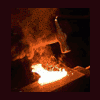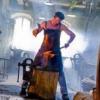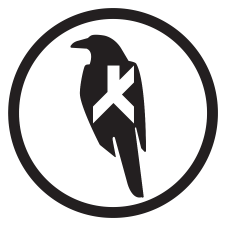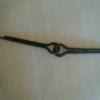-
Posts
228 -
Joined
-
Last visited
Profile Information
-
Gender
Male
-
Location
Orange County NY
Recent Profile Visitors
-

Forging a "Type D" Inspired Axe.
Matthew Paul replied to Matthew Paul's topic in Axes, Hatchets, Hawks, Choppers, etc
Thank you very much Benton -

Forging a "Type D" Inspired Axe.
Matthew Paul replied to Matthew Paul's topic in Axes, Hatchets, Hawks, Choppers, etc
Thank you. I use 3 drifts. The first two are commercially available through most blacksmith supply shops, and the final drift I sized the same as the replacement tomahawk handles that you can get. -

Forging a "Type D" Inspired Axe.
Matthew Paul replied to Matthew Paul's topic in Axes, Hatchets, Hawks, Choppers, etc
Thank you Interesting, I edited the post. Does it work properly now? -

Forging a "Type D" Inspired Axe.
Matthew Paul posted a topic in Axes, Hatchets, Hawks, Choppers, etc
I have not been on the forum in quite a while, but here is one of the many projects that I've completed. It is a "Viking" axe, modeled after some axes that fall into the Petersons Typology of "D" As it has been from the time that I started making this some years back, my work has been heavily influenced by that of James Austin and the work that he did with Jeff Pringle. I've tried many different methods and starting stock sizes and shapes, however I have found my work to be the most consistent by starting out with 1" square A36, about 4" long. The one side then gets "upset" to build up the material for the front portion of the axe, and the rear section stays about 1" square for the eye. Next the hole that will become the eye is hot punched slowly with hand hammers. After the eye is punched, it is drifted out about 75% of its final size. The edge is hot cut, beveled, opened and cleaned to accept the high carbon steel bit, which will then be forged to shape, and forge welded into the axe head. Here you can see the axe fresh from forge welding with a little clean up work to remove the excess bit material, and a little clean up around the edges. I normally have less material to remove post forging but it has been a long time since I forged one of these. You can also see the higher carbon material used for the bit showing black in the photo. Cleaned up and etched, ready for heat treatment. The heat treated axe with the material that it started out as. That's a LOT of hammer work. Test fitting the tapered handle: Here is the finished axe on the fire treated and oiled handle. I took the axe out to clear out some shooting lanes where Ill be putting up a new tree stand this year for deer season. Thank you for having a look, perhaps next time I can take more detailed photos. -

Forging Progression on Bearded Axe
Matthew Paul replied to Matthew Paul's topic in Axes, Hatchets, Hawks, Choppers, etc
Thank you. That is how I have always done it, but I did not on this one and I was not thrilled with how it worked out, although it did work. I usually cut teeth into the bit, but I have riveted it before welding before. It worked well. The cool thing with doing it that way is there is a mechanical back up in the event that a weld fails in use, although I would not count it it. The history is always interesting. You are most welcome, and thank you. I'll post up a photo or two when it is finished, although the customer wants a rearward curving handle, not my ideal choice but that is what the want. -
I've got this one ready for heat treatment. The body was forged from 1" square A36, and the bit forged and ground from 80crv2. The first photo shows the axe ready to be heat treated, as well as the starting steel stock. A lot of the smaller steps are not shown, but this is what I had for photos. So, the block is heated only on one half, and then upset to form the most basic of axe shape. I kept the stock 1" wide at this point, but upset the profile of it. Then the eye is punched. I did this on the home made hammer as I no longer have a striker around to help out on the axes. The eye is drifted close to its final size, and the "ears" are forged out a little, with the drift in eye. Then the bit end of the axe is forged out closer to the final shape, about half way between the starting size and the final shape, in both height and thickness. After that I let the head cool, blast it, and cut the edge with the band saw. I usually use a torch with the head clamped in a vice, and cut it with a chisel, but my torches are out of gas so I just cut the slit instead. The mouth is opened up and the bit is forged to shape from bar stock. I clean the bit, and the mouth, then heat, flux, and lightly seat the bit. This is the first time that I have done an axe without cutting teeth into the bit, so that it would bite into and hold in the mouth cut while forge welding, and I wont be doing that anymore. Once the pieces were hot to forge weld the bit would slide around in the mouth cut. So, I used a step block in the hardy hole to but the bit against while I welded it. It worked out just fine, but some more care was needed while welding. After welding the axe was drawn out some and then allowed to cool so that I could trim the excess bit material away, and finish the forging. Yes, I could have hot cut the material away, but it can be difficult to hold the tapered axe head, keep the cutting plate in place, and operate the hammer and chisel. Doing this operation is much easier with a striker. I need to forge a small cutter for use on the power hammer, and make a cutting plate to sit on the bottom die. The axe is finish forged to shape, cleaned up a bit on the grinder, blasted, and ready for heat treatment. It is in the kiln now being normalized.
-
If you really wanted to clean it up some, a little bit of sand paper and maybe a sanding block to soften the edges on some of the hammer strikes would probably do. But from the photo it does not seem to be bad at all, the round horn end of the face seems to be pretty smooth. That is a nice anvil though. I like that style. Have you done any forging on it yet?
-

Bolt on power hammer dies
Matthew Paul replied to Jspool's topic in Power Hammers, Treadle Hammers, Olivers
What size is the current die plate? 3.5" square or 4??? and by bigger, do you mean wider front to back? longer? Running the two bolts would allow a deeper die. the angle in which you make the dies has a lot to do with the size of die that you can fit on the plate.For example my upper die plate is about 3 7/8" wide, and I run a 3" x 2" die. If I ran my dies at a 45deg angle instead of the approximate 30deg, I could fit much larger die blocks, an extra 1/2 wide. If I were to cut 1/4" from each corner of the die block, I could fit a 4" wide die. You cant really run larger plates as the hammer still needs to travel up and down in the guides, unless the travel is not enough that the die plate goes within the guides. -

Bolt on power hammer dies
Matthew Paul replied to Jspool's topic in Power Hammers, Treadle Hammers, Olivers
I just finished making a new set today, and saw this yesterday, so I took some photos. I do it basically the same way as Frosty, but like he said, there may be better ways. Started with 2" 1045 Cut it to 3" lengths and milled half of the dies to the angle that I wanted. Radiused the edges with a file Chamfered the bottom of the dies Clamped the top die plate and block to another piece of steel to help minimize warpage when welding (Im no expert welder) Welded the top die, bolted in place, bolted the bottom die plate in place, and tacked the bottom die block so that it lined up. And here they are, heat treat as required. -

welding 4140 bolt on dies
Matthew Paul replied to will52100's topic in Power Hammers, Treadle Hammers, Olivers
yeah, I agree. The bolt on dies are ok, and cheep to make. But, If I make another one I'd spend the extra time and coin on making it so that it took normal style dies. Good to hear that ya got it all fixed up. -

welding 4140 bolt on dies
Matthew Paul replied to will52100's topic in Power Hammers, Treadle Hammers, Olivers
It wouldn't be a bad idea to clean the die faces and sides really well with scotchbrite or some light sand paper so that you can see if the welding actually effected the temper or not. I use 1045 for mine so the heat treat is a bit different. But, if you have the time it may not be a bad idea to remove the entire die block from the plate, Put a nice 1/2" chamfer on the bottom of the die block (like you said), and then rebuild it with several passes. The problem with re welding the whole block, especially with 1/8" 7018 is the heat build up. I'd bet that you would soften them right up. I'm not sure what heat range you use welding 1/8 7018 but I tend to run in the 145 AC range, give or take, and that imparts some serious heat on a small piece like that. Best thing you could do is go for it and see what happens. The temper temperature called for on 4140, for around 50rc is only 400deg. If you don't have access to a kiln, I'd probably just weld it and call it good. If you do have access to a kiln, I'd probably just re heat treat the dies. -

Clontz/Spencer based hammer finished
Matthew Paul replied to Matthew Paul's topic in Power Hammers, Treadle Hammers, Olivers
Looks good ForgeMan32! Also, another video of the hammer: -

Clontz/Spencer based hammer finished
Matthew Paul replied to Matthew Paul's topic in Power Hammers, Treadle Hammers, Olivers
I finally got around to making some rounding dies for the hammer. Here is giving them a test run. -

Fancy W1 Center Punch
Matthew Paul replied to Matthew Paul's topic in Slitters, Punches, Drifts, etc
Thanks yall. The 3/16" round "fullering" was done with a chainsaw file, and the thin line next to it, a triangle file. You can see file marks on the piece if you look closely.



